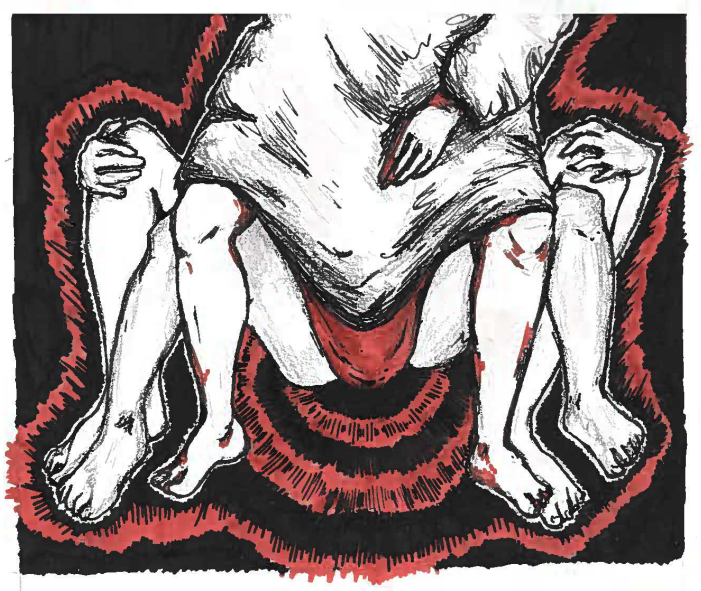Paula Rego’s The Untitled: Abortion Pastels: challenging the ‘male gaze’ and giving women power back
- Rattlecap Writers

- Dec 19, 2022
- 3 min read
Writing by Emma Brennan. Artwork by Alexandra Golds.
CW: abortion
White cisgender men have forever had a tight grip on the art world. This can be seen most strikingly in the way that female bodies have been exploited and sexualized in the name of ‘art’. With the ‘male gaze’ dominating art and depictions of female experiences and their bodies, there has often been a lack of raw, true representation of women’s experiences.
Take Titain’s Venus of Urbino, Gustave Courbet’s Origin of the World, or Balthus’s sexual paintings of pre-adolescent girls. The list goes on; you don’t have to look hard to find examples of the male gaze embodied in art. These paintings have a voyeuristic feel to them. The women (or, a lot of the time, young girls) are depicted as innocent, pure, and soft. The dominant theme in these paintings is the way that the male artists have depicted the women as passive subjects – purely objects at which men can gaze.
However, Paula Rego wants you to be uncomfortable, challenging this typical depiction of women by men. Rego, a British-Portuguese painter born in 1935, shocked the art world with her radical, and often dark paintings. Her paintings are designed to be unsettling; as she puts it, they depict the “beautiful grotesque”. Rego confronts the harsh realities of life, depicting war, sex trafficking, political injustice, illegal abortions, and genital mutilation.
There is nothing idealized or soft within her Untitled: The Abortion Pastels. Instead, she shows the horrifying experiences of young girls and women in the midst of illegal abortions. Rego doesn’t shy away from these painful realities but rather challenges the viewer to confront them.
In one painting, a woman is propped up on a bed with her legs spread open by two chairs, her face deadpan but her jaw clenched. Her hands grip the bedsheets, her knuckles white. In another, a girl squats over a black bucket, wearing what appears to be a school uniform. The settings of these paintings are decidedly non medical; the women are alone, sat on towels with their legs apart. Often, they face towards the viewer, their faces blank apart from a piercing look.

Paula Rego, Untitled No.1, 1998 (https://www.nationalgalleries.org/art-and-artists/features/importance-paula-regos-abortion-series)
These works were painted as a response to the failed referendum to legalize abortion in Portugal in 1998. Through these paintings, Rego forces the audience to confront the cruel realities of such restrictive abortion legislation.
Her paintings were shocking at the time and are still pretty shocking now. They expose the consequences of the abortion legislation in Portugal and the traumatic lengths that women have to go to in order to have control over their bodies. Abortion is a rare subject of art and while her paintings can be hard to look at, they are incredibly important in giving back agency to these women.
Rego not only exposes the realities of ‘backstreet abortions’ – she also defies what art can portray. She twists images of the traditional renaissance nudes, where women were placed looking towards the viewer with innocent gazes. Instead, the exposure of the women in her paintings is made to shock - there is nothing erotic or sexual about these women. These paintings are not made for the male gaze; rather they are to make men realise what happens when women are left no choice but to seek illegal abortions.
The women in her paintings are strong and stoic, while it is obvious that they are undergoing immense pain, their gazes are not full of guilt or fear. Rather they stare out at the viewer and force them to engage with their reality. Unlike much art produced by cis men, there is no sense that these women are passive subjects. Rather their steely gazes portray their strength and their control over their own bodies.
Rego’s paintings are confrontational; by portraying subjects that a patriarchal society have deemed taboo or immoral, she exposes these painful realities and challenges the viewer to confront them. Her work is immensely powerful, being credited with impacting the decision for Portugal’s second referendum on abortion, which saw abortion finally legalized in 2007. Paula Rego’s work is full of anger, pain and rebellion, but also empathy. Through her work she gives agency and control back to the women who have had it ripped from them by men. It is all this which makes Rego’s paintings so powerful and important.
Sources:






Comments